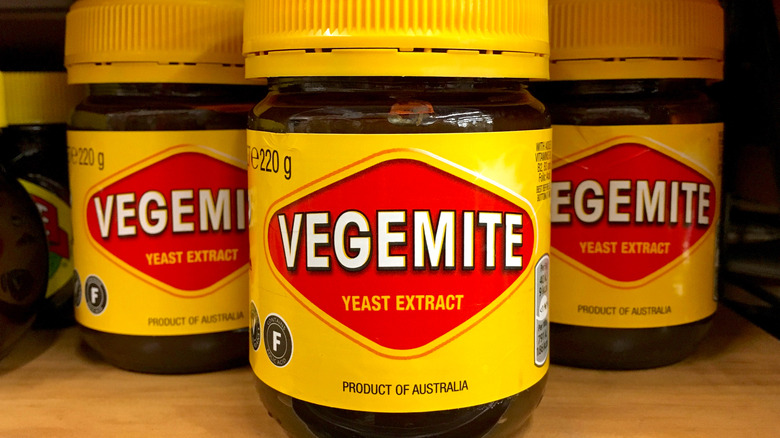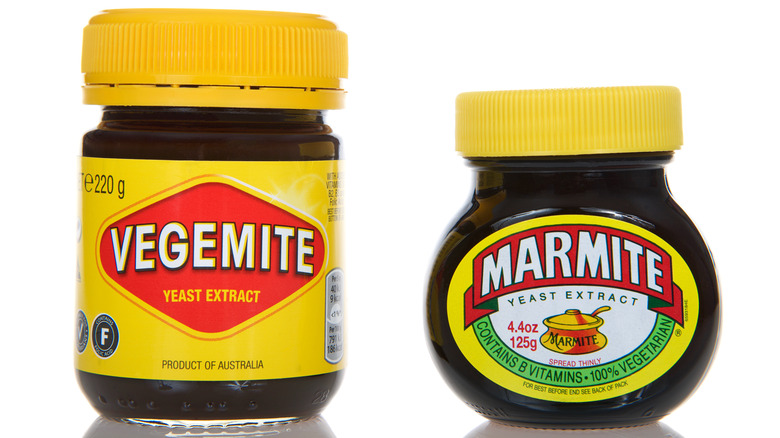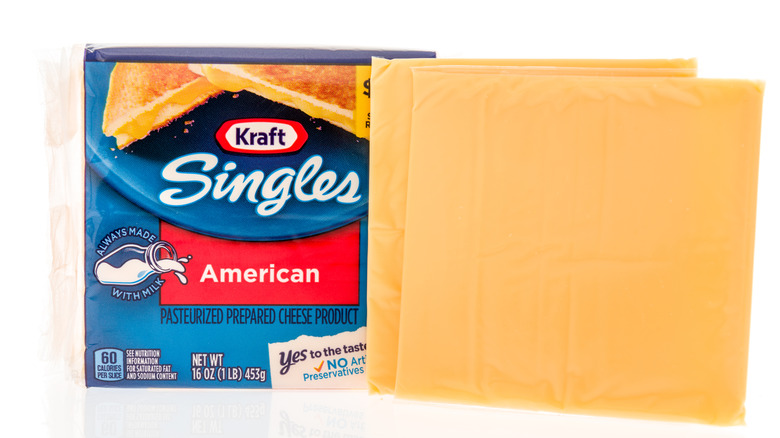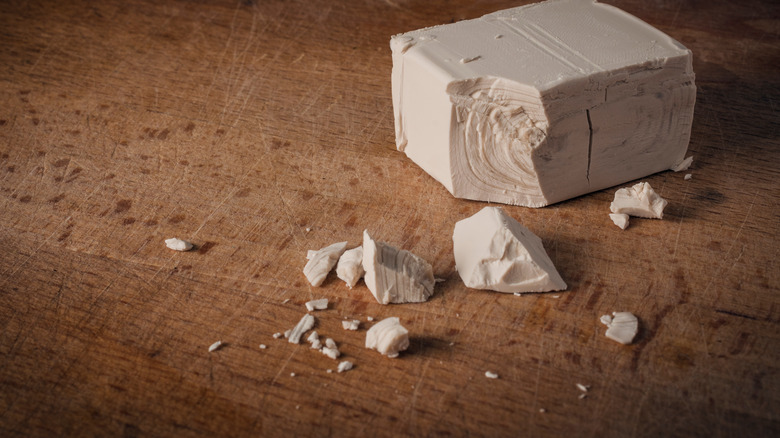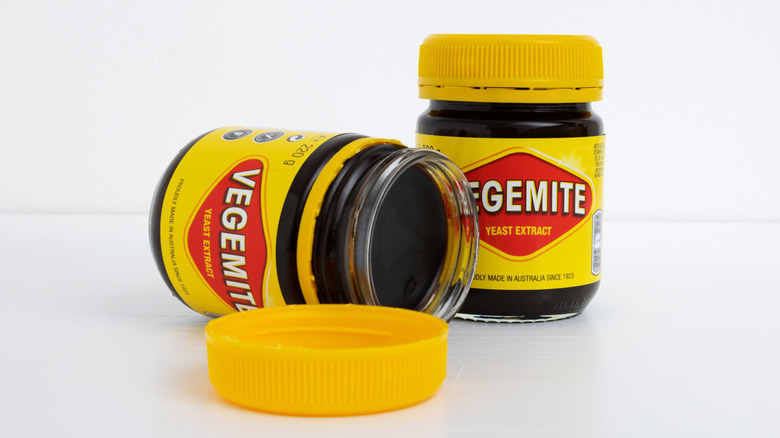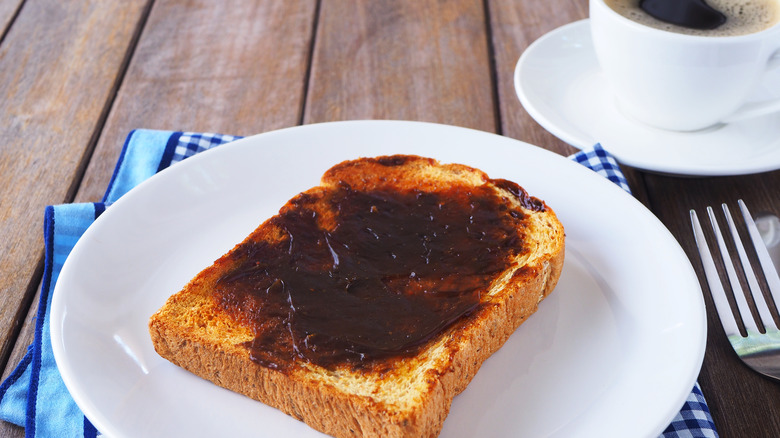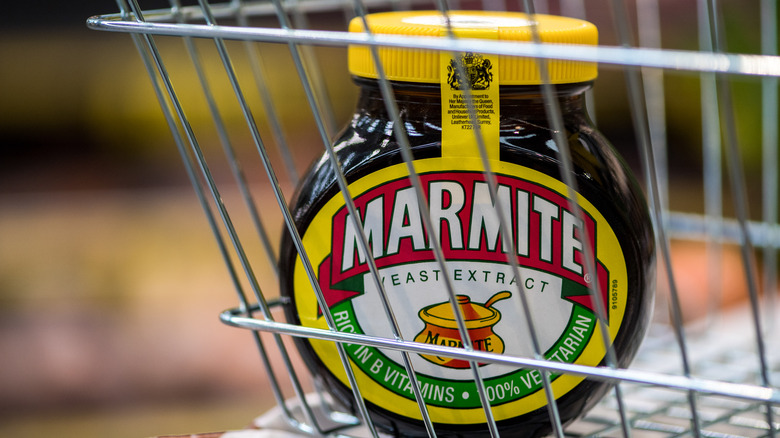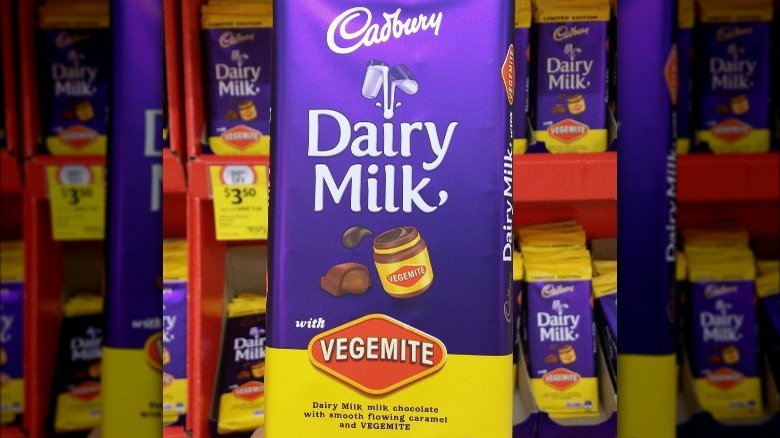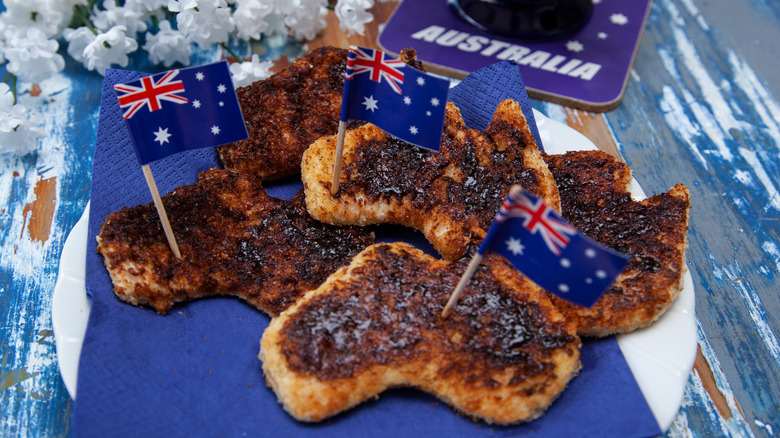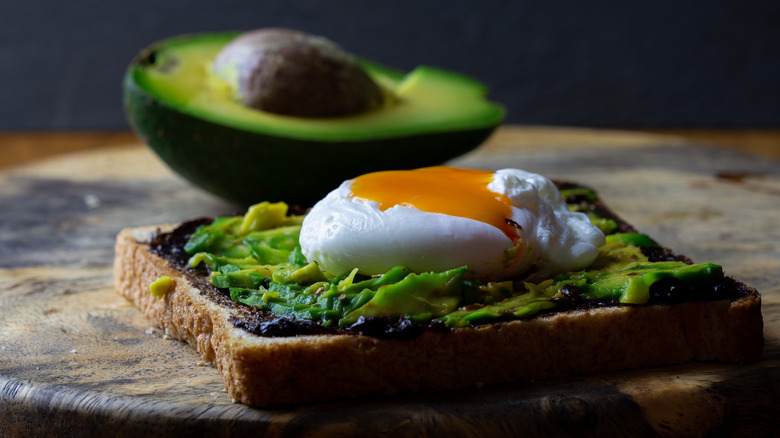The Untold Truth Of Vegemite
Outback Steakhouse. Fosters beer. Vegemite. All three of these things represent Australia in the American imagination, but only one of them gets love from real Aussies (hint: it's not the one with a ton of commercials narrated by a guy doing a bad Australian accent).
Vegemite is the true Aussie treat and the one that's hardest for people outside of the country to understand. While people who grew up on it go wild for the stuff, it's pretty hard to sell newcomers on a breakfast spread that looks like tar and tastes like bitter salt. However, if non-Australians simply got to know Vegemite a little better, they might even find that they like it just as much as people in the Land Down Under. We're here to help by sharing the spread's fascinating history and getting to the bottom of how it's made (or trying to, anyway). This is the untold truth of Vegemite.
World War I inspired Vegemite's invention
Before Vegemite, Australian shoppers were mad about Marmite. This earlier spread was developed around the turn of the 20th century by a German scientist who figured out a way to make a usable food out of brewer's yeast, a byproduct of the beer-making process. It has become a beloved foodstuff in the U.K., even earning a Royal Warrant from the British royal family (via PureWow).
Per Australian Geographic, Australians loved Marmite too, but unfortunately for them, it became difficult to import from Britain during World War I. After the war, inspired by the recent Marmite shortages, Aussie businessman Fred Walker charged a chemist named Dr. Cyril Percy Callister with developing a suitable replacement. It took him a few months, but eventually, he came up with a satisfactory formula, and Vegemite was released in 1923. The name came from a contest in which members of the public were invited to send in ideas.
It was not a success at first
Although it was invented as a Marmite replacement, Vegemite tastes rather different from its inspiration. Vegemite has a more intense, salty, bitter, and savory flavor than Marmite, and it's also thicker than its older cousin. Perhaps that's why it took a while for Vegemite to catch on in Australia.
After World War I, Marmite was back on store shelves Down Under, and it was the main player in the country's yeast spread market (via Vegemite). Consumers didn't really care to try a new product when they had one they already loved. What's Cooking America writes that Fred Walker was so desperate to turn around Vegemite's bad fortunes that the company renamed it to Parwill, coming up with the catchy slogan, "If Marmite ... then Parwill." The name change didn't do anything to goose Vegemite's sales figures, and the spread might have been relegated to a historical footnote had Walker not found an advantageous business partner in Kraft Foods (yes, the same Kraft behind the famous blue box of macaroni & cheese).
Processed cheese and World War II made Vegemite an institution
Per What's Cooking America, Fred Walker started manufacturing processed cheese in Australia on behalf of Kraft in 1925. The cheese business was doing well, so, in 1935, the company decided to try to use cheese to promote its struggling yeast spread (which by this point had gone back to the Vegemite name). Every time a customer bought any Kraft Walker product, they could redeem a coupon for a free jar of Vegemite. Apparently, giving away free stuff can sometimes be a good business move, as Vegemite's popularity skyrocketed because of the promotion.
Birthed because of World War I, Vegemite became even more ingrained in Australian culture during World War II, when the Australian government shipped it as rations both to its fighting men and its civilians. Just like another famous wartime ration, Spam, Vegemite was shelf-stable and easy to ship, and people kept eating it after the war ended.
Vegemite has inspired poetry and song
It's no secret that Vegemite is widely beloved in its home country. According to the Vegemite website, the company sells more than 22 million jars annually. Per the Australian Bureau of Statistics, the population of Australia is just shy of 26 million people, so that's almost a jar per person sold every year.
One of the ways the spread became such a fixture in its early years was by sponsoring a limerick competition. The company's official history notes that the 1937 contest, which gave out Pontiac cars to the winners, boosted Vegemite sales across the country. In addition to poems, the brand is also associated with a famous song, "Happy Little Vegemites." This advertising jingle from the 1950s is such an important part of Australia's cultural heritage that a commercial featuring the song is viewable on Australian Screen, a government website that is part of the National Film and Sound Archive of Australia. In it, four adorable moppets sing about how they eat Vegemite all day, every day.
Vegemite's recipe is a secret, but we know it has yeast
Vegemite notes on the FAQ on its site that the spread's recipe is "a closely guarded secret," so any attempt to figure out its actual ingredients involves a certain amount of conjecture. We can be sure that its main ingredient is brewer's yeast. The Daily Meal alleges that both Vegemite and Marmite start as brewer's yeast that is heated with salt to form a thick paste. This paste is very high in umami flavor, and it's what makes Vegemite so savory.
We also know Vegemite contains some blend of vegetable flavorings. In fact, the spread was first marketed as a "pure vegetable extract" (via Vegemite). What exact blend of vegetables goes into making Vegemite's distinctively bitter flavor is anyone's guess, but the recipe purportedly includes concentrates of onion and celery. Since Vegemite primarily tastes like umami and salt, we'll probably never know for sure what vegetables are in it unless some disgruntled employee goes rogue and spills the beans.
It can be used to brew alcohol
As we mentioned above, Vegemite's primary flavoring, brewer's yeast, is a byproduct of beer-making. It turns out that you can use it to make alcohol even after it's been turned into Vegemite. A 2007 story from The Age reveals that the spread was banned in prisons in the Australian state of Victoria because inmates had figured out how to use it to make illicit hooch. Prison officials believed that the incarcerated brewmasters had stolen fruit from the kitchen and added melted Vegemite. The yeast in the Vegemite fermented the fruit, turning it into alcohol.
A few years later, in 2013, an ABC article reported that people in areas of Australia's Queensland state where alcohol was banned had been using Vegemite to ferment Ribena, turning it into an alcoholic beverage. For those who don't know, Ribena is a kind of blackcurrant-flavored soft drink (via English Tea Store). We hope we don't have to say this, but please don't try brewing alcohol from Vegemite at home.
Vegemite is surprisingly healthy
Appeals to health and nutrition were a big part of Vegemite's early marketing strategy. According to What's Cooking America, in 1939, the British Medical Association actually gave the spread its stamp of approval, citing its high levels of B vitamins. While it might seem like a stretch to call something that's traditionally eaten on buttered white bread healthy, especially when it's so salty, WebMD notes that there's actually some merit to Vegemite's health claims.
Per WebMD, a one-teaspoon serving of Vegemite contains only 9 calories but boasts 1.3 grams of protein and 25-50% of your recommended daily value of four B vitamins: thiamin, riboflavin, niacin, and folate. And while the spread certainly tastes very salty, one teaspoon only works out to 5% of your daily limit of sodium, which isn't terrible, especially considering all the vitamins you're getting. If that's still too much salt, you can always eat nutritional yeast instead, which has all the same nutrients minus the sodium.
Australia's Kiwi neighbors prefer Marmite
Australia and New Zealand are right next to each other. Their accents sound similar, and Americans might have a little trouble telling them apart (forgive us, Aussies and Kiwis). Because of their proximity, you would think New Zealand customers would follow the lead of their Australian neighbors and eat Vegemite, but apparently, that's not the case. Kiwis love their yeast spread, but they're on team Marmite.
This preference became very obvious during a crisis that the NZ Herald jokingly called "Marmageddon." In 2012, New Zealand's only Marmite plant had to stop production briefly to repair earthquake damage. This caused a run on the spread and made the Marmite shelves of New Zealand supermarkets look like the toilet paper aisle at the beginning of the pandemic: empty. Although New Zealand's then-prime minister, John Key, told the Herald that he liked Vegemite just fine, it seems as though his fellow citizens didn't agree, as the Marmite shortage led the price of a single jar to spike over $60 on an auction site.
Cadbury made a Vegemite chocolate bar
Vegemite is salty, savory, and bitter, so it's not the first ingredient you would think of as a good candidate for a chocolate bar filling. However, sometimes savory flavors work great in candy form; salty caramel is basically a cliché at this point, and super-dark chocolate is inherently bitter all by itself. Maybe a Vegemite chocolate bar is an idea just off-the-wall enough to actually work?
We think the pairing might have promise if some artisanal chocolate maker gave it a try, but according to The Guardian, Cadbury's attempt at combining milk chocolate and Vegemite tasted pretty dismal. The main reviewer found that the Vegemite flavor, while present, lacked the zip of the real thing, and instead tasted "old" and "not pleasant." Even worse, the aftertaste lingered long after its welcome had worn out. The writer's coworkers were also almost universal in their distaste for the bar, save for one who enjoyed it and compared it to "salted caramel but with a pleasant yeasty aftertaste."
It's also shown up in sausages and popsicles
Candy isn't the only unexpected home Vegemite has found itself in over the years. As reported by News.com.au, Australian supermarket chain Coles started selling Vegemite and cheese-flavored lamb sausages that they marketed as "perfect for Australia Day." While the idea seemed to enrage the author of the article (a Vegemite purist who thinks it only belongs on toast), we think that these weenies would probably taste great. Lamb sausage is already delicious, and we can't imagine some extra savory flavor from Vegemite and cheese having anything but a positive effect.
More suspect, however, is the other Vegemite food mentioned in the article: an icy pole. Judging by the included picture, icy pole is the delightfully whimsical Australian word for a popsicle. We could imagine this maybe working if it was savory, but apparently, it was a sweet ice pop flavored with Vegemite. That's a hard "no" from us.
Hugh Jackman schooled Jimmy Fallon about Vegemite
With its intense and unique flavor, Vegemite is an undeniably divisive food, but many people who are unfamiliar with the product don't eat it the correct way when they try it for the first time. They slather the highly-concentrated spread on too thickly and pronounce it "disgusting" because they're eating way too much at one time. Such was the case with Jimmy Fallon when he first sampled it on his show. Proud Aussie Hugh Jackman couldn't let Fallon's Vegemite slander stand, so he took it upon himself to demonstrate proper Vegemite technique to the host when he appeared on "The Tonight Show" (via YouTube).
In the clip, Jackman patiently explains that Vegemite is at its best when you spread a tiny amount onto a piece of soft, buttered white toast. Eating it the right way totally changes Fallon's opinion of Vegemite. Jackman also shares a piece of Vegemite toast with Questlove, who says he enjoys it.
For most of its history, Vegemite was owned by an American company
Although Vegemite is the quintessential Australian treat, the company was owned by foreign businesses until recently. Per What's Cooking America, Walker sold the secret recipe to Kraft in 1935. At the time that Cadbury's Vegemite bar was released, in 2015, the brand was still owned by Kraft, which by that point itself was owned by U.S.-based food giant Mondelēz International (via The Guardian).
However, after nearly a century of Vegemite's profits going to support U.S. corporations, ownership of the brand finally came back home to Australia in 2017. The ABC reported that Australian dairy company Bega bought the rights to produce most of Kraft's food brands for the Australian and New Zealand markets. The deal included Kraft cheese, peanut butter, mayonnaise, and most importantly for our purposes, Vegemite. As part of the deal, Bega took over the factory where Mondelēz had been manufacturing those products.
You can use it to boost umami in recipes
While Vegemite is most commonly used as a spread for toast or crackers, it's also a versatile ingredient that can add an umami kick to various recipes. The Australian-based site delicious. suggests making beef pies, cheese scones, brownies, and even Bloody Marys, all incorporating Vegemite. A What's Cooking America reader from New South Wales, Australia, also recommended adding it to gravy and sandwiches. Tasting Table notes that food manufacturers use yeast extract to add umami flavor to food much in the same way that MSG is used, and Vegemite is a type of yeast extract. If you're imaginative, we bet you can find many dishes that would benefit from the savoriness of a little dab of Vegemite.
If you need some inspiration on that front, the Vegemite website has many recipes on it, and most of them don't seem as nasty as the icy poles (though there's one for Vegemite-laced brownies that we're a little suspicious of).
